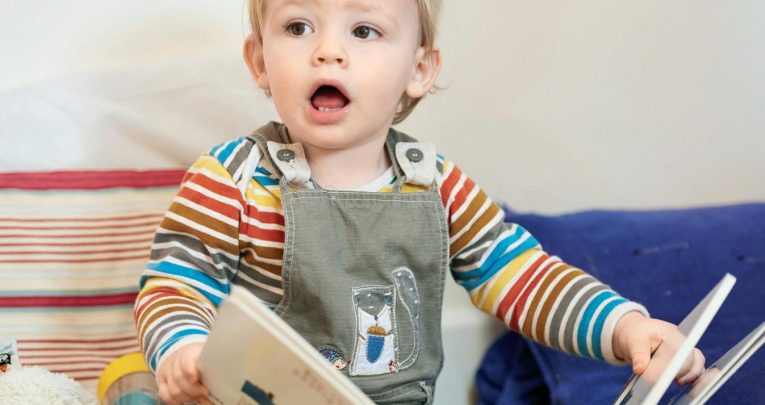How To Introduce Young Children To Books

Provide children with ongoing opportunities to enjoy and engage with the contents of your library, and you will give their literacy development the perfect foundation, says Hilary White…

- by Hilary White
- Former nursery and primary teacher, freelance writer and consultant

Books are the cornerstone of literacy – and one of the most important strategies that we can follow is to make books an ever-present part of young children’s daily lives, both in our settings and, through our partnerships with parents, at home. From helping children to discover the fun of a good story, to becoming familiar with print on a page, books are an essential part of literacy development in all its many aspects.
The big question is how to go about introducing books. During the early years, our role is to facilitate rather than to teach literacy. As such, our provision should fall into three broad areas:
- Organising the setting to display books in an appealing and accessible way.
To put this into practice in your setting, try the following ideas…
The environment
The book corner
Your book corner needs to work for all the children in your setting. There are certain basics it is important to get right, such as making sure the corner is comfortable, peaceful, and has display units that the small children can access without your help. If you have room, it’s also useful to have a place for a special book collection and wall space for bookrelated artwork too.Once you have your book corner set up, observe how the children use it. Do they find the books easy to get at? Are there any sections that remain unused? Is the space for reading set apart from the thoroughfare for moving around the area? Make any necessary adjustments based on your observations of the children, and give them the chance to practise practical tasks such as putting a book back on the shelf.
Book displays
Help the children explore books with themed displays. There are endless categories to choose from, including topics, a particular author/artist or a favourite character. You can also make a collection where each child chooses their favourite book, and help older children to ‘curate’ their own collection. Keep an eye on the collections to make sure they don’t get stale. Update and change them regularly – and spark interest in a new addition by introducing it during circle time.Books throughout the setting
Think of your setting as one big book corner. Put themed books alongside corresponding activities and areas, such as books on vehicles by the small-world play garage, and books on garden birds and trees by the window. Have a portable outdoor book area so that children can discover the pleasures of reading in the sunshine and link books with an outdoor theme to their own outdoor environment.Story sacks
Make up story sacks and boxes for favourite books, with small props, pictures and a recording of the story. Encourage the children to take a story sack home with them.Story role-play
Encourage children to explore stories through play by putting out props, dressing-up clothes, small-world play settings and creating role-play settings linked to the book. Involve the children as much as possible in creating the settings and finding their own props to link to the story.‘Book of the week’
Encourage interest by spotlighting a particular book. Give the book its own display in the book corner with a story sack or play props. Put out more than one copy, and if possible include different formats (hardback, paperback, board book, big book) as this will help children discover the variety to be found within the world of books. If a character has merchandise, such as Elmer the Patchwork Elephant, include it in the display. Make linked posters, friezes or mobiles and display alongside artwork generated by the book. Explore alternative endings and ‘what happened next’ scenarios (“What do you think the Very Hungry Caterpillar did after he turned into a butterfly?”). Encourage the children to make up their own stories about the main character.
Sharing books
One-to-one story sessions
Commit to adult/child story sessions whenever possible. While they are not always easy to fit in, the one-to-one story session gives unparalleled opportunities to converse about the book, respond to questions, scaffold the child’s understanding of the story, give the child time to study the pictures and move through the book at the child’s pace. One-to-one story sessions should ideally take place with the child’s key worker, but you can also draft in students and other helpers.Foundations for reading
Sharing stories gives children endless opportunities to witness the process and purpose of reading: looking at the printed pages, making sense of the marks on the paper and turning them into spoken language. This plays a far more important part in the beginnings of reading than we might realise. Books also provide a great opportunity to absorb letters, letter clusters and common words. For this reason, it’s important to ensure that the child can see the page as you are reading. Make reference to how you are reading the words, can’t read the next bit of the story until you’ve turned the page and so on. With older ones, you can also occasionally run a finger under the print as you read – although don’t overdo it, or it will lose its impact.Exploring stories
Learning how a story works is essential to becoming a reader in a holistic sense; for example, discovering that there is a beginning, a progression of events, an ending, a main character, a setting and so on. Encourage and enable exploration of the story as a narrative with role play, story boards, recounting favourite stories, making up new endings, focusing on a main character with art work and dressing-up clothes, and looking at the features of the settings in the pictures.Choosing books
Work hard at choosing topics to appeal to your children. There are picture books to be found on just about any topic, and picking just the right one is particularly useful for encouraging the more reluctant child. For example, Eric Carle’s From Head to Toe is great for the child who struggles to sit still because they can join in the actions. Books can also be used to help children make sense of specific life events.Apart from asking the children’s librarian at your local library, if you still have one, Amazon.co.uk is a useful resource. Simply type in key words and go from there. Goodreads.com and booktrust.org.uk also have some useful lists.
Group storytime
Although one-to-one stories are important, group storytime plays an essential part in introducing children to books. Here’s how to make the most of your sessions…
- Ensure that the children can see the pictures at all times. Hold the book to one side, learn to read upside down so you can hold it open on your lap, and try using big books.
With key story events, build expectation with a ‘pregnant pause’ before turning the page.
Hilary White is a former nursery and primary teacher. As an author she has written a number of books and contributed to a range of magazines










